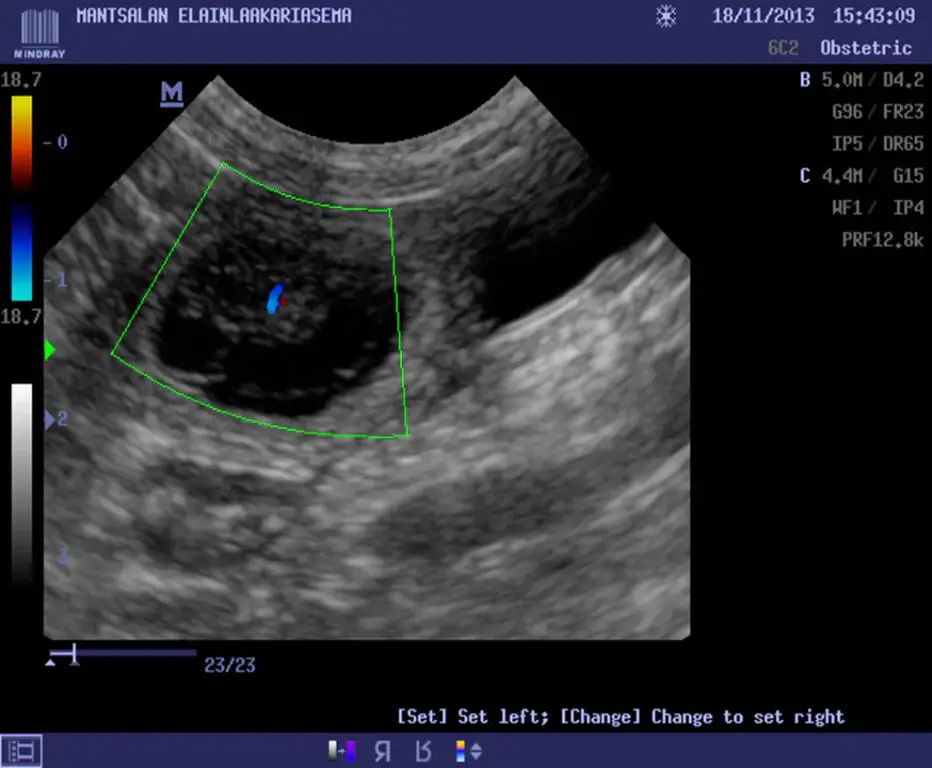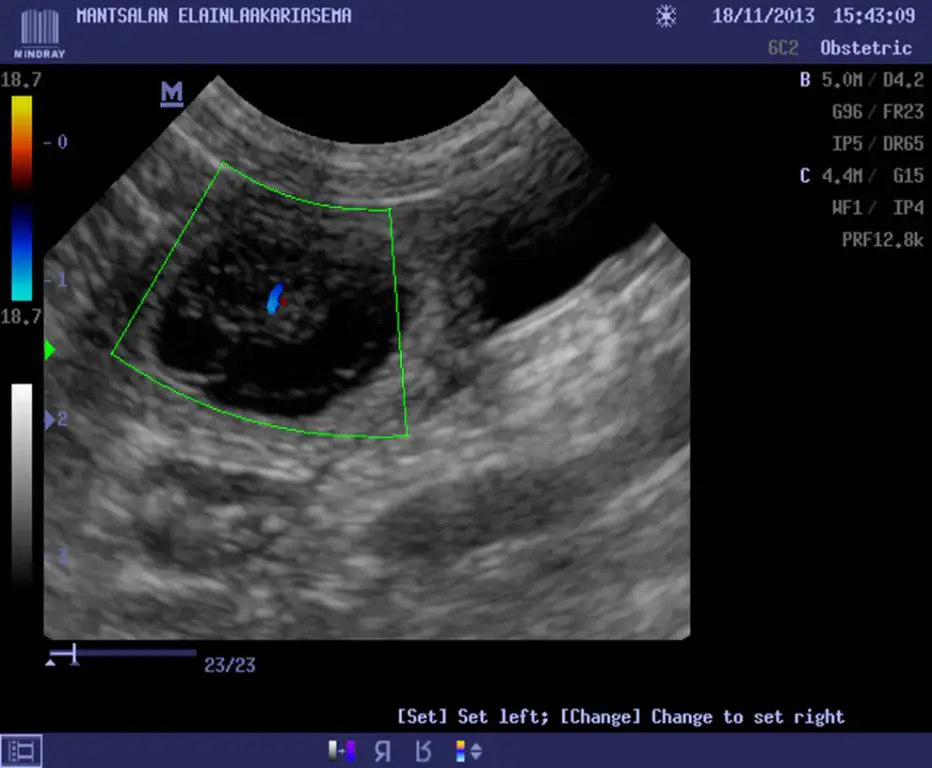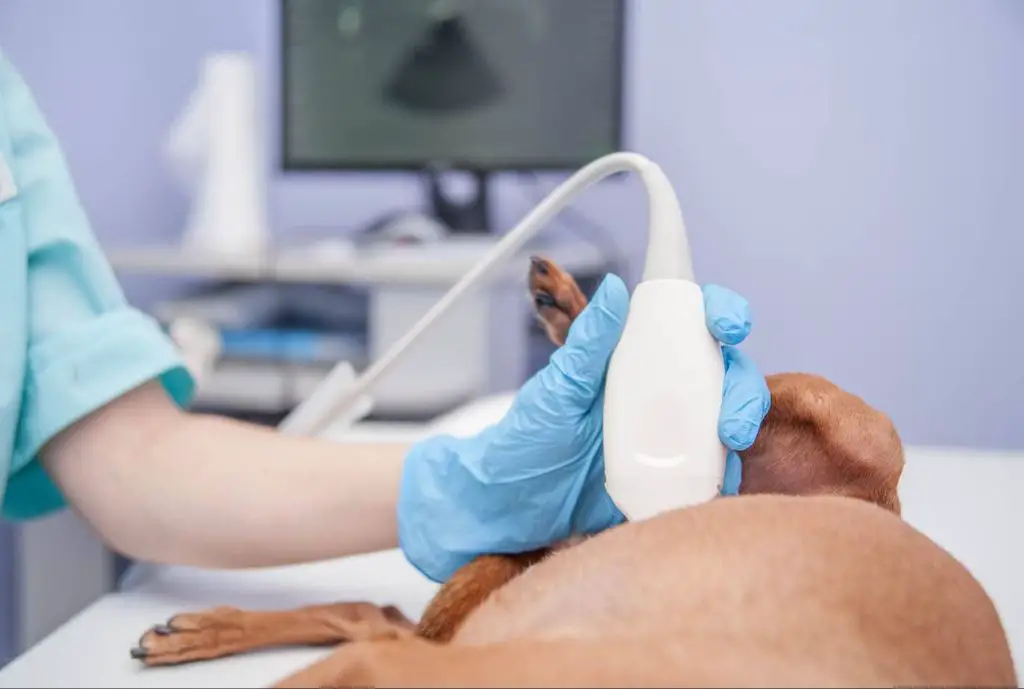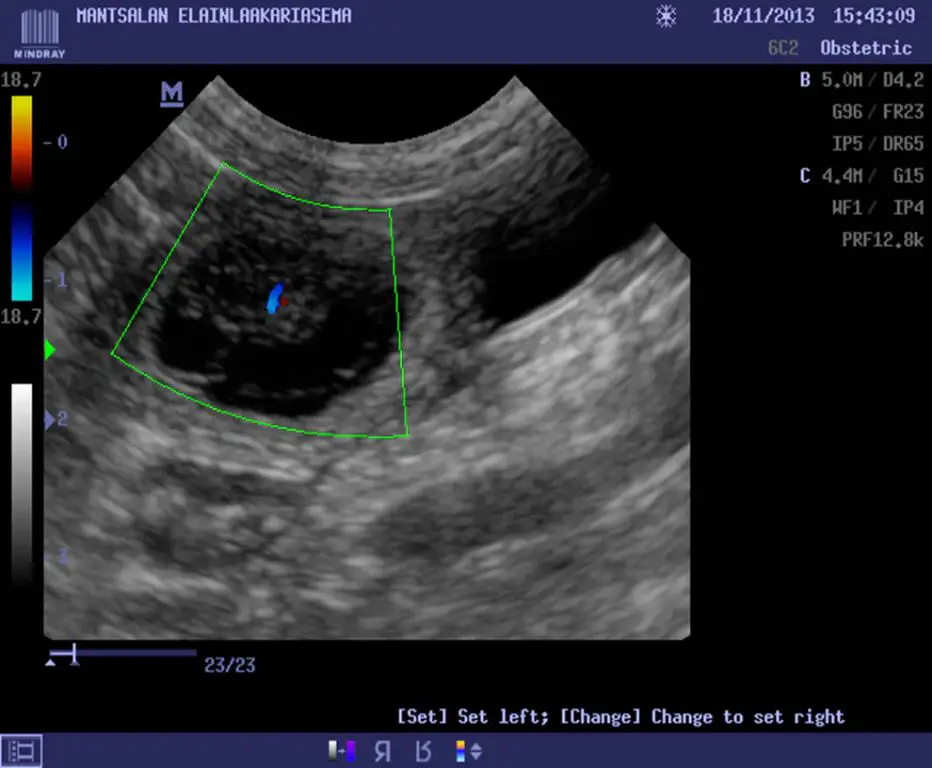Introduction
A 4 week ultrasound for pregnant dogs is an important diagnostic tool used to confirm pregnancy and monitor fetal development in the early stages. At around 28 days into the pregnancy, ultrasound can reliably detect fetal heartbeats and visualize the gestational sacs. Veterinarians will recommend an ultrasound between 25-35 days post-breeding to provide an accurate pregnancy diagnosis and rule out pseudo-pregnancy. This early ultrasound is critical for proper prenatal care, allowing vets to determine litter size, due dates, and any potential issues to monitor. Understanding what to expect from a 4 week ultrasound scan can help dog owners prepare and know what to look for in the results.
This article will provide an overview of when vets conduct 4 week pregnancy ultrasounds, what they look for, how to prepare a dog for the procedure, interpreting the results, costs, limitations, and frequently asked questions.
When During Pregnancy Do Vets Perform Ultrasounds?
Veterinarians typically recommend an ultrasound between days 25-35 of a dog’s pregnancy to confirm the pregnancy and determine how many puppies to expect (Animal Ultrasound Association 2022). An ultrasound in the first few weeks, around 4 weeks or 28 days, is less common but may be done to distinguish a very early pregnancy from a potentially dangerous condition called pyometra (East Central Veterinary Clinic 2021).
In early pregnancy, around 4 weeks, the fetal puppies are very small and difficult to visualize on ultrasound. However, some veterinarians will perform an ultrasound this early to rule out pyometra or to get an initial look if the exact breeding date is unknown. While detection may still be difficult this early, an ultrasound at 4 weeks can provide an indication of whether the dog is pregnant before the embryos develop further (GetWellue 2022).
The most reliable time for confirmation and accurate puppy counting is an ultrasound between weeks 4-5. This balances early detection with improved visualization of the developing puppies. Some vets may wait until later at 6-7 weeks for optimal viewing. However, an early ultrasound around 4 weeks can give owners peace of mind if pregnancy is suspected.
What Will the Ultrasound Show at 4 Weeks?

At 4 weeks of pregnancy, an ultrasound is typically able to detect embryos and some early signs of fetal development in dogs 1. The embryos will appear as small fluid-filled sacs, and it may be possible to see evidence of heartbeats developing. The skeletons and other organs are just starting to form at this stage, so they won’t be visible yet.
Specifically, a 4 week ultrasound may reveal 2:
- The number of embryos present. Experienced vets can get an initial count of the litter size from a 4 week scan.
- The embryos’ location in the uterine horns. This helps assess their spacing and viability.
- Fetal heart motion. Flickering hearts can often be detected at this stage.
- The gestational sac forming around each embryo.
- The difference between viable embryos and any reabsorbing ones.
So while full anatomical features aren’t observable yet, a 4 week ultrasound provides valuable information about the timing of conception, number of puppies, and the progress of embryonic development.
Preparing Your Dog for the Ultrasound
Proper preparation of your dog is an important step before the 4 week pregnancy ultrasound procedure. This helps ensure the vet can get clear images and accurate results.
Most vets will ask that you fast your dog for 6-12 hours before the ultrasound appointment. This prevents food in the stomach from blocking the view of the uterus and puppies. Only allow access to water during this fasting period.
The fur around the abdomen will need to be closely clipped or shaved. Ultrasound waves cannot transmit through air, so any fur in the way will impact the imaging. Trimming the fur down to the skin allows for full contact of the ultrasound probe.
It’s also crucial to keep your dog calm and relaxed. A stressed or anxious dog may pant heavily or move around, which can affect the ultrasound. Consider giving your dog a walk or play session to tire them out before the appointment. You can also ask your vet about giving a mild sedative if your dog has high anxiety.
Arriving early to the vet clinic can help get your dog comfortable in the new environment. Bring along some favorite toys or treats to help keep them occupied and distracted during the procedure. With proper preparation, your dog will be ready for the vet to capture those important first images of the puppies.
For more details on preparing for your dog’s pregnancy ultrasound, check out this article: https://vcahospitals.com/know-your-pet/ultrasound-examination-in-dogs
What to Expect During the Ultrasound
The ultrasound procedure is straightforward and non-invasive. Here is a step-by-step overview of what to expect:
The veterinarian will have you position your dog on her back or side on the examination table. They may gently restrain her to keep her still during the procedure. The abdomen area where the ultrasound will be performed is shaved if necessary.
A gel is applied liberally to the shaved area. The gel allows the ultrasound waves to transmit from the scanner to the skin and back. Without it, the images would be obscured.
The veterinarian will then move the ultrasound scanner slowly over the gel-coated skin. The scanner emits high frequency sound waves that penetrate the skin and bounce off the internal structures and fetuses. This creates a picture that is visible on the screen.
The veterinarian will take images and measurements from different angles and positions to thoroughly evaluate the pregnancy. The number of fetuses, their size, heart rate, and position in the uterus are assessed.
The ultrasound usually takes 10-20 minutes from start to finish. Some gentle pressure may be applied with the scanner to get optimal views, but it is generally not uncomfortable for the mother dog.
After the ultrasound, the gel is wiped off and the fur cleaned. You will discuss the findings and next steps with the veterinarian. An early pregnancy ultrasound provides valuable information but requires follow up scans later in pregnancy to fully monitor fetal health.
Interpreting the Results

Once the ultrasound images have been captured, the vet will carefully analyze them to determine if the dog is pregnant and how the pregnancy is progressing. According to Belly Labs, the vet looks for several key signs of pregnancy on the ultrasound:
- Fetal heartbeats, which can be detected as early as 3-4 weeks into the pregnancy (1).
- Fetal skeletons forming, first visible around week 4-5 (1).
- The number and size of the fetuses, which give an estimate of gestational age (2).
- The shape and tone of the uterus, which changes significantly during pregnancy (3).
The vet will also assess each fetus for any abnormalities, though it can be difficult to detect problems this early. According to North Maclean Family Vet, vets look at the fetal position, size, heart rate, spine formation, and placental attachments (2).
Normal results would show a uterus enlarging in size, visible fetuses of the expected gestational size with detectable heartbeats, and no obvious abnormalities. Abnormal results may include fewer fetuses than expected, fetuses appearing small or malformed, or indications of resorption or miscarriage.
The vet will explain the ultrasound findings to the pet owner, including whether the dog is definitively pregnant, how many puppies there appear to be, their developmental progress, and any areas of concern. They can then discuss next steps for prenatal care based on the specific details of that pregnancy.
(2) https://www.northmacleanfamilyvet.com.au/DogPregnancyandWhelping.aspx
(3) https://embassylakesanimalhospital.com/blog/dog-pregnancy/
After the Ultrasound
The next steps after the 4 week ultrasound will depend on the results. If the ultrasound confirms pregnancy and the vet doesn’t identify any issues, the focus will shift to providing proper prenatal care for the remainder of the pregnancy. It’s recommended to follow up with another ultrasound later in the pregnancy to monitor development.
If the ultrasound is inconclusive at 4 weeks, the vet may recommend waiting 1-2 weeks and repeating the scan for confirmation. An inconclusive result doesn’t necessarily indicate a problem, as it can sometimes be difficult to visualize the fetuses this early.
In cases where the ultrasound detects issues like resorbing fetuses or abnormalities, the vet may discuss options with the owner. Sadly pregnancy loss can occur, and the vet can help determine next steps such as terminating the pregnancy or allowing it to progress while monitoring closely.
No matter the results, proper nutrition and care is essential following the initial pregnancy ultrasound. Feed a high quality puppy food and avoid strenuous exercise. Follow your vet’s guidance on supplements and medications that support healthy fetal development.
Regular veterinary check ups are recommended throughout the pregnancy every 2-3 weeks. Ultrasounds may be performed periodically to monitor fetal growth and position. Proper prenatal care greatly improves chances of a healthy pregnancy and delivery.
Cost of 4 Week Pregnancy Ultrasound

The typical cost range for a 4 week pregnancy ultrasound in dogs is $50 to $200 or more, depending on your geographic location and veterinarian. Generally, an ultrasound is the most common type of pregnancy scan used for dogs 1. What’s included in the price is the ultrasound procedure itself along with the veterinarian’s interpretation of the results.
Some factors that influence the cost are:
- Where you live – Prices tend to be higher in urban areas and coastal cities.
- Your vet’s qualifications – Those with advanced training like board certification may charge more.
- Type of machine used – Newer or higher-end ultrasounds usually cost more.
When budgeting for the procedure, be sure to consider the exam fee, fees for sedation if needed, and fees for any additional tests like bloodwork. Some vet offices offer ultrasound packages that include everything needed for a discounted price.
Limitations of Early Ultrasounds
While ultrasounds at 4 weeks of pregnancy can provide some valuable information, there are limitations to consider. According to “When Can You Scan a Dog for Pregnancy” and other sources, early ultrasounds have less accuracy than later ultrasounds. This is because the puppies are very small at 4 weeks, making it harder to get clear images and count them reliably.
The main risk of relying too heavily on a 4 week ultrasound is that it may miss some puppies or underestimate the litter size. According to “Canine Pregnancy: Radiography vs Ultrasound”, the detection rate at around 4 weeks is only 60-85%. This increases to nearly 100% accuracy by 6-7 weeks as the puppies grow larger.
For this reason, vets recommend following up any early ultrasounds with another scan later in pregnancy to confirm the puppy count. Relying solely on a 4 week ultrasound could lead to being underprepared for a larger litter. The best approach is to use early ultrasounds for an initial estimate, then re-evaluate with a second scan for maximum accuracy as delivery approaches.
Frequently Asked Questions
Here are some common questions pet owners have about 4 week pregnancy ultrasounds for dogs:
When is the earliest an ultrasound can detect pregnancy in dogs?
Ultrasounds can generally detect pregnancy in dogs as early as 3-4 weeks from conception, according to Belly Labs. At 4 weeks, the ultrasound allows vets to confirm pregnancy and examine the size and development of the fetuses.
What will a 4 week pregnancy ultrasound show?
At 4 weeks, the ultrasound will confirm pregnancy by detecting the gestational sacs developing around each fetus, according to Embassy Lakes Animal Hospital. The number of fetuses may be counted at this stage. Fetal heartbeats are generally detectable around 5 weeks.
Is a 4 week ultrasound accurate for counting puppies?
While a 4 week ultrasound may detect and count gestational sacs, the puppy count may not be totally accurate this early, according to vet Dr. Regina. The developing fetuses are still small and some may be obscured by others on the ultrasound image. Counts are more reliable after 5-6 weeks.
How much does a 4 week dog pregnancy ultrasound cost?
Costs vary, but expect to pay $100-$300 for an ultrasound at 4 weeks pregnancy. Prices depend on your location, vet office, and whether sedation is needed for the procedure. Confirm costs beforehand with your vet.
Can I get ultrasound pictures at 4 weeks?
Yes, ultrasound photos and video can usually be captured at 4 weeks, according to petMD. The images will show the gestational sacs and developing fetuses. While they may not be highly detailed yet, they can be exciting for pet owners to see.
